No. 15/2002, p. 4f.
Ralf Kluttig-Altmann: Report on the 15th Meeting of the Arbeitskreis
zur Erforschung der Tonpfeifen held in Grefrath on 28-30 April 2001
The Arbeitskreis zur Erforschung der Tonpfeifen (German Society
for Clay-Pipe Research) held its 15th Meeting on 28-30 April 2001.
Twenty five participants from Germany and one from Holland and several
visitors attended the Meeting, which was held in the Niederrheinische
Freilichtmuseum Dorenburg in Grefrath at the invitation of the Museum
Director, Heinz-Peter Mielke. A venue for the Meeting was chosen
in the German, Belgian and Dutch border region to make it easier
to visualise the close relationships that existed in the 18th and
19th centuries, particularly in the production, marketing and consumption
of clay pipes and tobacco in this region, which today is transected
by national borders. Two excursions, one to Weert in Holland and
the other to Andenne in Belgium, were specially planned to relate
to this topic.
The complete version of this paper can be found here.

|
|
|

zoom
|
No. 15/2002, p. 8-18
Rüdiger Articus: "There have always been pipes".
The history of clay-pipe research in the 19th century
The author explains how, in the past, clay pipes found in excavations
of prehistoric or ancient sites were often attributed to ancient civilizations.
From the 1820s onwards, clay pipes repeatedly turned up in excavations
of Celtic and Roman sites, mostly in south Germany, Switzerland and
France, and, since the typical shapes of the 17th century clay pipes
had mostly been forgotten, the finds were attributed to the ancient
civilizations. Contemporary national feeling in the 19th century used
to exert a considerable influence on how history was interpreted.
For example, the idea that a cultural achievement with as broad a
popularity as tobacco smoking was acquired from the "savages"
of America was utterly unacceptable to the academic community in Germany
and central Europe in the 19th and 20th centuries - a truly European
origin had to be found, and preferably a very ancient origin! Although
this subjective kind of thinking was abandoned by the middle of the
20th century, one still finds the old ideas turning up, even today,
in exhibitions, lexica, and other publications. In this connection,
metal pipes, which were occasionally found in the 19th and 20th centuries,
still pose an unsolved problem, although they are possibly metal imitations
of Dutch clay pipes.

|
|
No. 15/2002, p. 19-34
Michael Schmaedecke: A draft typology of floral decorations
on pipe stems based on material found in SW Germany and the surrounding
region and mostly made in the Mannheim/Frankenthal area
In contrast to the manually impressed decorations on pipe stems,
there is a large group of pipes with stem decorations that were
engraved in the pipe mould. Many pipe fragments exhibiting the latter
type of decoration have been found in SW Germany and the surrounding
regions during the last few years, most of which were produced in
the Mannheim/Frankenthal area. The floral decorations are subdivided
into three hierarchical groups on the basis of various criteria
such as the type of motif, the position and extent of the decoration,
and its relationship to an inscription, if present.
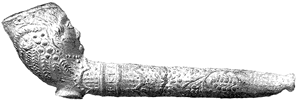
Clay pipes with floral decoration, made by Julius West in Mannheim
in the 1690s.
The typology permits small fragments, such as are often found in
excavations, to be classified, and it is sufficiently flexible to
allow new groups, even those of other production centres, to be
integrated into all levels of the hierarchy. It is hoped that, eventually,
the typology will prove to be a useful tool for determining the
age and provenance of clay-pipe fragments, perhaps even allowing
the pipe maker to be identified.
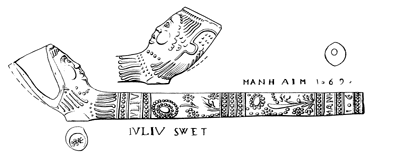
Clay pipes with floral decoration, made by M. Kesselhum.

|
|
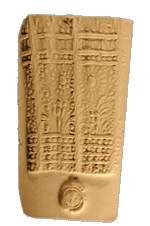
Rolled impression
of the stem decoration.
|
|
No. 15/2002, p. 35-50
Regina Geiss-Dreier: Clay-pipe finds in Schloss Oberstein.
The clay tobacco pipes found in the castle Schloss Oberstein show
that the habit of tobacco "drinking" started in the upper
River Nahe region during the second half of the 17th century, at the
latest. Pipe smoking was introduced by the French troops of Ludwig
XIV during the "Reunion" time and the Palatinate wars of
succession, as has been demonstrated for other castles in this area.
According to the names and places marked on the clay pipes, they mostly
originated from clay-pipe factories in the Palatinate, particularly
from Frankenthal. This is also true of many pipes bearing marks and
initials that have previously not been seen or identified. The clay-pipe
finds from Idar-Oberstein show that trade in clay pipes produced in
the Mannheim-Frankenthal area extended not only southwards but also
to the north and northwest. Schloss Oberstein on the upper reaches
of the River Nahe is the most northerly occurrence known so far.
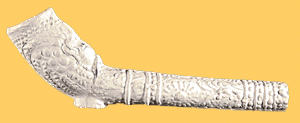
Clay pipe made by Otto Kissius of Frankenthal, marked "OK"
above a triangle.
The find of a heelless pipe dated 1736 demonstrates that tobacco
was smoked at Schloss Oberstein in the 18th century. That of a 'Wortmann
pipe' shows that clay pipes were obtained from Westerwald during the
first half of the 18th century. It is not yet known, however, whether
clay pipes were imported from pipe makers in Holland. This question
can only be answered when the finds have been studied in more detail.
In particular the polished clay-pipe fragments and those displaying
an unusual decoration must be carefully looked at. So far it is only
possible to say that import of clay pipes from the Netherlands was
confined to the 18th century.

|
|
No. 15/2002, p. 51-64
Helmut Szill: Clay pipes from Erding. Part 2
Most of the clay pipes found at Erding are either plain or decorated
ones from the 17th century. The importance of these finds lies not
only in the variety of different models but also in the large number
of fragments bearing initials. The initials, always in relief, appear
on some pipes on the side of the bowl and on others on the heel.
The initials include TCB, ISC, CB, LP and RV. During this preliminary
evaluation of the material, it was not possible to compare each
model with similar material from other complexes. It is clear that
the distribution of these pipes, in spite of their comparatively
poor quality, is very wide and covers the whole of the region of
south Germany. At this stage of the research, unless archaeological
or documentary evidence turns up unexpectedly, we must be satisfied
with 'south Germany' as provenance. Eventually, the initials mentioned
above will enable the production centre(s), which were certainly
of considerable importance, to be localised.

|
|
|

zoom
|
No. 15/2002, p. 65-71
Natascha Mehler: Tobacco and clay pipes on Iceland in the 18th
century, based on finds in the Aðalstræti, Reykjavik
This paper deals with clay-pipe material found on Iceland and places
it in its historical framework. Certain long forgotten, written documents
provide useful evidence that tobacco was grown successfully on Iceland,
at least for a short time, during the 18th century. Clay pipes, on
the other hand, were not manufactured on Iceland but were imported
indirectly from Holland, England and Scandinavia via Danish traders.
Altogether 268 pieces of clay pipe were found during excavations at
Aðalstræti 14-16, Reykjavik, where a wool mill was situated
in the 18th century. These pipes mostly originate from Holland (Gouda),
and others are from Denmark (Stubbekøbing and København)
and England (Bristol). Six clay-pipe makers' names appear on the pipes:
F.VERSLU (Frans Verzyl) and LUCAS DE IONGE from Gouda, R TIP PET (Robert
Tippet) from Bristol, A·ROSS (Alexander Ross) and S·Fe
(Severin Ferslew) from Denmark. The name WVVELSEN has not as yet been
identified.

|
|
No. 15/2002, p. 72-78
Heinz-Peter Mielke: The Lower Rhine clay-pipe region. The distribution
of clay-pipe production between Cologne and the Netherlands
The Lower Rhine region was always a good market for clay pipes from
Westerwald and Holland. However, in spite of this, repeated attempts
were made between Cologne and the Dutch border to establish clay-pipe
factories to supply local and regional markets.
(Clay-pipe production centres in the Lower
Rhine area)
Some of these attempts met with success, some had less luck; the
political conditions invariably provided the necessary framework
for business success. An account is given of 14 production centres
which were active in the period between the early 17th century (Cologne)
and the second World War (Hoisten). That at Neuss is a slight exception
since clay pipes were only processed there.

Notice circulated by the Prussian Kriegs- und Domänenkammer
inviting clay-pipe makers to settle in towns in the Lower Rhine
area;
from the Duisburgische Adresse- und Intellegentz-Zettel, 1750s.

|
|
|
No. 15/2002, p. 79-84
Bärbel Bollinger-Spang & Martin Kügler: From
clay pipes to clay flowerpots
Taking the Westerwälder Blumentopffabrik Spang GmbH &
Co. KG in Ransbach-Baumbach, Westerwald, as an example, it is
shown how a firm succeeded in surviving by making judicious
changes in its production program. In 1912, Wilhelm Spang (1876-1952)
left the clay-pipe factory that his father Peter Spang I founded
in 1884, since he saw unmistakably that world demand for clay
pipes was dropping, and looked for new products that he could
manufacture.
|
|
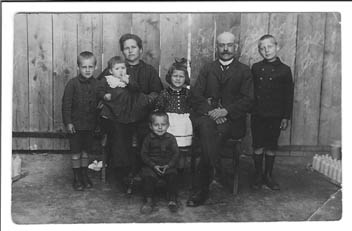
Wilhelm and Christina Spang and their children, about 1932.
|
|
He decided to specialise in salt-glazed stoneware for household
use, and unglazed flowerpots made of red-firing clay. Specialising
on these products, his excellent sense of business and his inventiveness,
which enabled him to streamline production, helped him to survive
the difficult period between 1918 and 1945. His sons expanded
the firm during the 1950s to make it the world-wide market leader
in the field of flowerpot manufacture.
|

|
|
No. 15/2002, p. 85-89
Ralf Kluttig-Altmann: Guidelines for preparing drawings of clay
pipes
A drawing of an archaeological object should provide the viewer,
who of course would not have seen the object itself, with a "substitute",
which can never be as good as the original but can contain the relevant
details. If a drawing is going to contain an optimal amount of (optical)
information about the object, and if the viewer is to be enabled
to visualise the object, then certain drawing standards should be
adhered to.
The complete version of this paper can be found here.

|
|
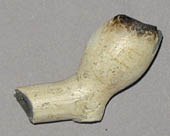
One of the oldest pieces of material evidence so far found documenting
tobacco smoking in Saxony: Pipe bowl produced in Holland around 1620.
|
|
No. 15/2002, p. 90-95
Martin Kügler: Clay pipes from the Schönhof in Görlitz
During renovation work on the historical buildings of the Schönhof
in Görlitz, several fragments of 17th and 18th century clay pipes
were found in fill between the first and ground floors. The oldest
of these clay pipes can be dated as around 1620 and is inferred to
have been imported from Holland. This unusual specimen, which is unique
amongst the Schönhof material, is the oldest piece of material
evidence so far found documenting tobacco smoking in Saxony. There
are also four pieces of heelless pipes with cylindrical bowls and
curved stems. These pipes are particularly interesting since they
were clearly made in a two-piece mould with no decoration engraved
in it; the pipe maker evidently impressed the decoration on the bowl
by hand after removing the pipe from the mould. The material from
Schönhof resembles clay pipes that have been excavated in Breslau/Wroclaw
(Poland) and Zittau in large quantities. We can thus infer that, during
the second half of the 17th century, there must have been a production
centre of considerable importance in the Saxony/Silesia region and/or
in one or more of these three towns.
Clay pipes from the Schönhof, Görlitz, with hand-impressed
decoration on bowl; provenance unknown, second half of 18th
century.
|
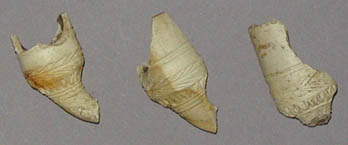 |
The very broken fragments of 18th century pipes also found were possibly
made by the Wille family, pipe makers who were active in Görlitz
from 1777 to shortly after 1830. No products of Wille's pipe factory
have as yet been identified with certainty.

|
|
No. 15/2002, p. 96
Martin Kügler: An 18th century Jonah-and-the-whale pipe
Two examples of an unusual type of clay pipe have recently been
found at different localities in Stockholm, Sweden. The bowl shows,
in relief, a man's face with bushy eyebrows, a large nose and a
long, curling moustache, reminding one of the Jonah-and-the-whale
pipes of the 17th century. Both pipes have a "foot" as
heel mark, on the left side of which is the Gouda coat of arms.
The shape of the bowl gives the age as no earlier than about 1750.
This means that the possible makers are Jan Osterhout or Thomas
Verhage. A clay pipe with a Jonah-and-the-whale design is very unusual
for this period, since, according to the present state of our knowledge,
this type of pipe was not produced after 1700.

|
|
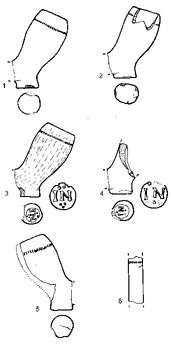
Fragment of pipe made by John Newall, Cleobury Mortimer, 1680-1710.
|
|
No 15/2002, p. 97 f.
David Higgins: Report on the discovery of a pipe kiln near
Cleobury Manor, Shropshire, England
As early as 1948, scattered clay-pipe fragments were found on
a field belonging to Barnsland Farm, about 1.5km SW of Cleobury
Mortimer. A trial excavation in 2001 showed that the site was
undisturbed and exposed the foundations of a building. The bases
of stone walls and abundant remains of a pipe kiln and pottery
- dated between 1640 and 1720, the remains of the pipe kiln
were dated somewhat more accurately as between the years 1680
and 1710. Some of the clay pipes are marked with two initials
'IN'. The house and the clay-pipe factory most probably belonged
to the clay-pipe maker John Newall, who died in 1719. This man
is also mentioned in contemporary documents including his will
dated 2 March 1718 or 1719 and an inventory of his possessions
dated 11 May 1719. Newall was both a farmer and a craftsman
who was helped by his family with his clay-pipe production.
Since no other clay-pipe makers are known from this area, it
is likely that he found sufficient customers for his pipes in
the local markets. However, the fact that some of his pipes
were marked suggests that he also sold them at larger markets. |

|
|
No. 15/2002, p. 98 ff.
Martin Kügler: Clay-pipe finds in Geelbek, Republic
of South Africa
A large number of Stone Age artefacts and more recent material
were found scattered over an area of about 3km2 on a huge
wandering sand dune. Out of this material, nine fragments
of clay pipes are described, only three of which display marks.
The clay pipes originate from Gouda and were made around 1750
and/or in the second half of the 18th century and then exported
to South Africa.
Dutch clay pipes found in Geelbek, Republic
of South Africa.
|
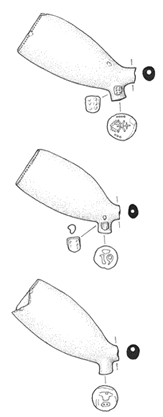 |
|
|
|
|
|
